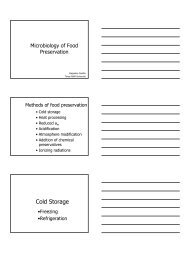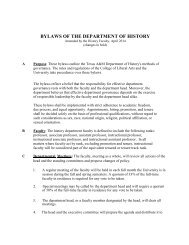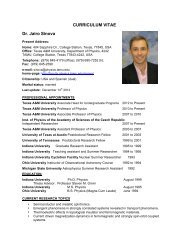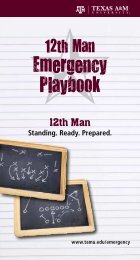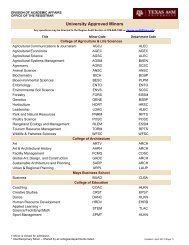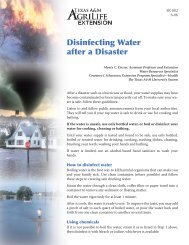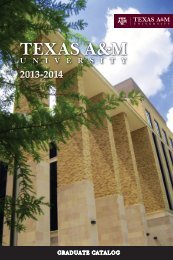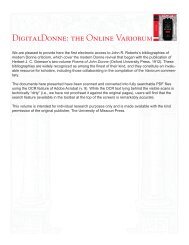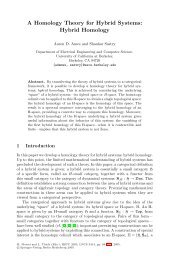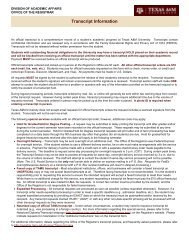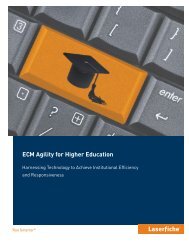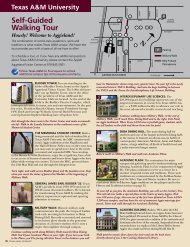ODP Final Technical Report - Ocean Drilling Program - Texas A&M ...
ODP Final Technical Report - Ocean Drilling Program - Texas A&M ...
ODP Final Technical Report - Ocean Drilling Program - Texas A&M ...
Create successful ePaper yourself
Turn your PDF publications into a flip-book with our unique Google optimized e-Paper software.
065251Impact SiteContinentsas they were65 millionyears agoOutline ofmodern daycontinentsDrill SiteEquator543The drillship, JOIDES Resolution, recovered asediment core from the seafloor 563 km (350 mi)east of modern day Florida at a water depth of2,658 m (8,860 ft). This core was recovered 2,011km (1,250 mi) from the now-buried impact crater.It contains a detailed history of the asteroidimpact and its effects on the Earth. The mapabove shows the shape and location of thecontinents as they were 65 million years agowhen the impact occurred.The <strong>Ocean</strong> <strong>Drilling</strong> <strong>Program</strong> (<strong>ODP</strong>) is an internationalpartnership of scientists and researchinstitutions organized to explore the evolutionand structure of the Earth. The program’sresearch vessel, JOIDES Resolution, has traversedthe world’s oceans since 1985 collectingcylindrical cores of sediment and rock from theseafloor. By studying the cores and loweringinstruments into the drill holes to study thesurrounding seafloor, <strong>ODP</strong> scientists gain a betterunderstanding of Earth’s past, present, andfuture. <strong>ODP</strong> is sponsored by the U.S. NationalScience Foundation and <strong>ODP</strong> internationalmembers.For more informationVisit these web sites: www.nmnh.si.edu/paleo/blast andwww.oceandrilling.org. Or contact: <strong>Ocean</strong> <strong>Drilling</strong> <strong>Program</strong>,Joint <strong>Ocean</strong>ographic Institutions, 1755 Massachusetts Avenue,NW, Suite 800, Washington, DC 20036-2102, USA; (202) 232-3900; joi@brook.edu.This sediment core recovered by the <strong>Ocean</strong> <strong>Drilling</strong> <strong>Program</strong> recordsthe cataclysmic event that changed life on Earth 65 million years ago.64.965.065.1AFTER THEIMPACT:Only tiny, lessornate foraminiferamicrofossilsare found in thislayer; a few newspecies have evolved. Notice the tremendousdifference in size between the foraminiferamicrofossils shown here compared tothose from before the impact.FIREBALL LAYER:Contains dust and ash fallout from theasteroid impact.EFFECTS OF THEIMPACT:Ejecta including tektites– glassy spherules condensedfrom the hotvapor cloud producedby the asteroid impact– are found in this layerof the core. Debris thrown into theatmosphere by the impact rained downon the Earth for days to months after theevent. The impact and ensuing globalclimatic changes devastated life. In theocean, 95 percent of the free-floatingforaminifera died out.MOMENT OF IMPACT:K/T (Cretaceous/Tertiary) BoundaryBEFORE THEIMPACT:This layer containsmicrofossils of thelarge and ornateforaminifera thatflourished in theoceans during thetime of the dinosaurs.An asteroid nearly 10 km (6 mi) wide slammed into what is nowMexico’s Yucatan Peninsula and blasted debris into the atmosphere.When the dust cloud settled, a 177 km (110 mi) wide crater scarred theEarth. A large number of marine and terrestrial creatures became extinct.Foraminifera are single-celled organisms thathave inhabited the oceans for over 500 millionyears. They come in many shapes and sizes. Thisliving, free-floating foraminifera from the Caribbeanhas just captured its next meal. When theorganism dies, its spiny shell will be preserved onthe seafloor as a microfossil. Their abundance,wide distribution, and sensitivity to environmentalvariations make the foraminifera indicators of pastclimate change. By studying foraminiferamicrofossils scientists can better understandancient organisms, environmental conditions,and dramatic events in Earth’s history.How do we know that the extinction in the oceanalso occurred on land? Scientists have recoveredcontinental cores containing iridium, shockedquartz, and soot from global wildfires thatcoincide with the mass extinction at sea. Thisevidence allows scientists to visualize whatconditions must have been like on land. After theasteroid impact, a searing vapor cloud spednorthward. Within minutes, the North Americancontinent was in flames. The rain of burningdebris from the impact caused wildfires andturned most of the land into a “global broiler.”Super hurricane-force winds scoured the Earth.Ash, soot, and debris darkened the skies causingsub-freezing temperatures over most of the landsurface for weeks to months after the impact.Many species were extinguished by the blast fromthe past, including Triceratops. Small mammals likethe ones in the foreground survived. This pivotalevent changed the course of evolution.Outreachof the community with research done onthe ship.• Congressional Visits—These annual eventsbrought scientists, engineers, researchers,educators, and technology executives toWashington, D.C., to raise visibility andsupport for <strong>ODP</strong>.• Media Relations Efforts—<strong>ODP</strong> outreachpersonnel created media lists and developedrelationships with national and foreigncorrespondents/science journalists.• Science and Industry Conferences—<strong>ODP</strong> outreach activities at nationaland international science and industryconferences included exhibit booths, mediaevents, public meetings, posters, individualseminars, and special symposia. Annualexhibit venues included conferencesorganized by the American GeophysicalUnion (AGU) and the Geological Society ofAmerica (GSA), among others.Scientific community leaders providedbrief updates regarding <strong>ODP</strong> at public“town hall” meetings held at various scienceconferences such as the AGU Fall Meetingand the GSA Annual Meeting. This venuegave members of the community theopportunity to ask questions and commenton <strong>ODP</strong>.• Laboratory and Core Storage FacilityTours—<strong>ODP</strong>-TAMU Staff Scientists, the<strong>ODP</strong> Curator, and the curatorial staff ateach repository conducted guided tours ofthe laboratory and repository facilities topromote public interest in <strong>ODP</strong>.• Educational Outreach—<strong>ODP</strong> staff and<strong>Program</strong> participants gave presentations inclassrooms and set up exhibits for “ScienceDays” at museums and schools throughoutthe United States. Lamont-DohertyEarth Observatory (LDEO) of ColumbiaUniversity also highlighted <strong>ODP</strong> at theirannual fall Open House. Presentationsand exhibits included general informationabout <strong>ODP</strong> as well as specific leg resultsand accomplishments. <strong>ODP</strong> cosponsoreda program called “<strong>Ocean</strong> <strong>Drilling</strong> DistanceLearning <strong>Program</strong>,” in which a teachersailed on <strong>ODP</strong> Leg 194 and recordedlectures that were broadcast to shore anddisseminated to schools engaged in thedistance learning program (oceandrilling.coe.tamu.edu). Other educational outreachinitiatives included partnering with theBlast from the Past<strong>Ocean</strong> <strong>Drilling</strong> <strong>Program</strong> science at theSmithsonian’s National Museum of Natural HistoryOne bad day, 65 million years ago...Millions of years agoPaleozoicMesozoic CenozoicThe impact: where and whenThe <strong>Ocean</strong> <strong>Drilling</strong> <strong>Program</strong>John Beck, <strong>ODP</strong>/TAMUDeep-sea core shows impactMillions of years agoBrian Huber, NMNH, Smithsonian Inst. Brian Huber, NMNH, Smithsonian Inst. Brian Huber, NMNH, Smithsonian Inst.63Tiny creatures tell a big storyWhat happened on land?Christoph Hemleben, University of Tuebingen ©Mary Parrish, NMNH, Smithsonian Institution



